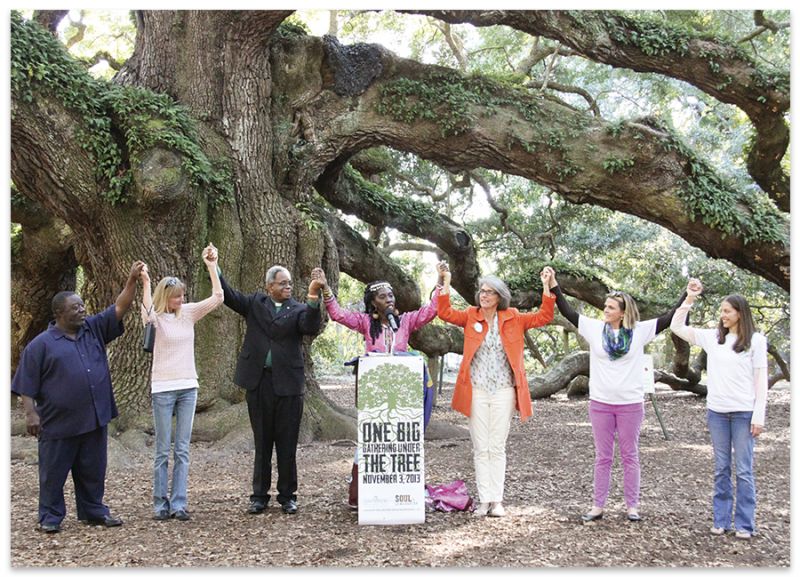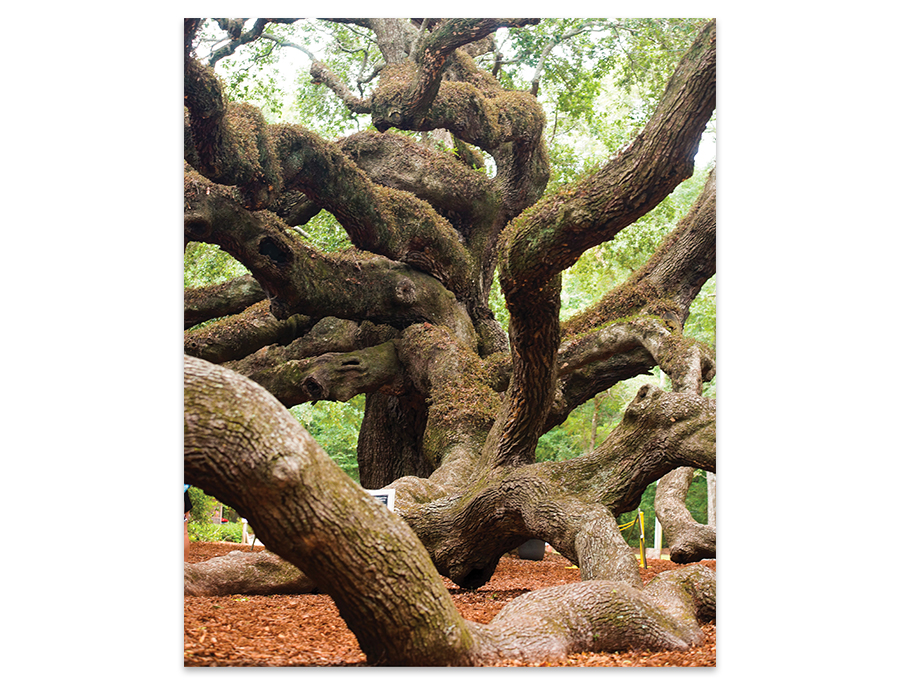Work on a 44-acre park is expected to get underway next year

The Lowcountry Land Trust partnered with Save the Angel Oak almost a decade ago to protect 35 acres surrounding the tree. Those efforts are coming to fruition in the coming year.
Just over a decade ago, the future ofthe land around the Angel Oak on John’s Island seemed poised for dramatic change. A housing development had been approved in the near vicinity, awaiting only wetlands-fill and storm water permits and final design approval. The woods that surround the sprawling live oak—a maritime forest rich with towering magnolias, grand oak trees, and biodiverse wetlands—were on track to become an apartment complex and mixed-use retail. Even then-mayor Joe Riley said it was a done deal.
Instead, the land is now owned by the Lowcountry Land Trust (LLT), which will soon expand the four-acre park into a 44-acre preserve that includes trails and boardwalks, a picnic pavilion, and a children’s nature play area. “The Angel Oak is an iconic space. It’s a sacred space,” says Ashley Demosthenes, LLT president and CEO. “The land around it should be a contemplative, passive preserve that allows the public to have an immersive experience.”
The stunning shift from condos to parklands began with Samantha Siegel, an activist and writer who mobilized a petition campaign against the development in 2008. She co-founded the Save the Angel Oak organization and partnered with Coastal Conservation League to fight the project’s wetlands-fill permit. That prolonged legal battle, aided by South Carolina Environmental Law Project, led to a foreclosure on the property, opening the door for LLT to purchase two parcels, totaling 35 acres, that surround the tree on three sides. Those will be combined with nine acres owned by the City of Charleston (including the four acres within the existing fenced park) to form the new preserve.
“The Angel Oak is an iconic place. It’s a sacred space. The land around it should be a contemplative, passive preserve.” —Ashley Demosthenes, Lowcountry Land Trust president
Siegel now works with LLT as the Angel Oak project manager, collaborating with landscape architect firm Nelson Byrd Woltz and arborist Cameron Rickett. By expanding the park and moving parking farther from the tree’s root system, the team hopes to protect the sprawling landmark even as visitation increases. About 400,000 people visit the tree annually, with as many as 3,000 on peak days. “The tree is the first and foremost priority,” says Rickett, explaining how moving the gift shop and bathrooms outside of the park footprint will help to reduce soil compaction over the root system, “therefore making the tree healthier.”
Plans for the expanded preserve, which will begin to come to fruition in 2023, feature interpretive displays about the Gullah-Geechee and Native American history of John’s Island. The land includes archaeological sites of both a former indigenous settlement and cabins for enslaved workers. That plays into the value of preserving the land for the community. More than 12,000 donors contributed $7 million for the parcels, plus contributions from the South Carolina Conservation Bank and Charleston County Greenbelt.

An estimated 400,000 people a year visit the 65-foot tall Angel Oak, which is believed to be between 300 and 400 years old.
“I’ve always had the viewpoint that it’s worth every penny,” says Demosthenes. “Ten years down the road, people aren’t going to remember how much it costs—they’re going to remember that we saved it.”
The Land Trust’s purchase of the “connective tissue” around the Angel Oak guarantees that generations of sightseers will have a non-commercialized experience. They’ll soak in the surrounding vistas of mature forests versus paved roads and buildings. Demosthenes explains that the project is inspiring other conservation efforts across the Lowcountry, citing the “Angel Oak Effect.” In an era of political divisiveness, community efforts to secure the land’s preservation have transcended partisan differences. “This tree really is a symbol,” she says. “It’s a catalyst for bringing people together and passing it forward to the next generation.”
Meg O’Halloran, the Land Trust’s chief advancement officer, refers to the Angel Oak as “charismatic megaflora.” Much like the presence of wild tigers or pandas can inspire preservation efforts for forests in other parts of the world, this ancient live oak tree shines a light on the value of our sea island ecosystems. “By focusing on this one point, we can help to protect an entire forest and island,” says O’Halloran. “There’s a magnetic power to this tree that draws people in. And then you can understand the importance of an entire ecosystem that can create a tree like this.”